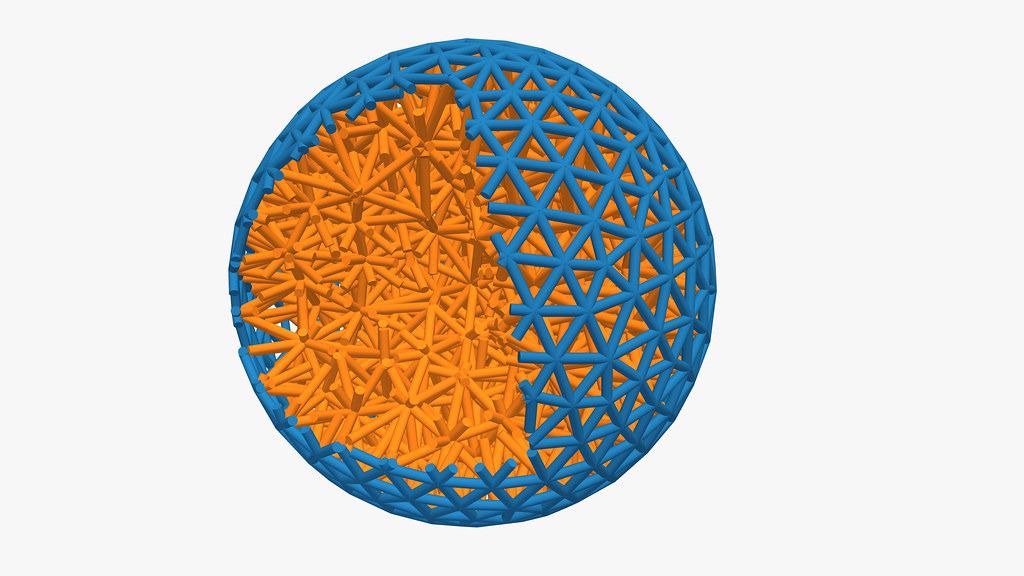Soft robots can now be coated in materials that help them to move and operate in a more purposeful manner, according to scientists. The research, which was conducted by the University of Bath, was published in Science Advances.
 Active matter: Wrapping an elastic ball (orange) in a layer of tiny robots (blue) allows researchers to program shape and behavior. Image Credit: Jack Binysh.
Active matter: Wrapping an elastic ball (orange) in a layer of tiny robots (blue) allows researchers to program shape and behavior. Image Credit: Jack Binysh.
The study’s authors feel that their breakthrough modeling on “active matter” might be a watershed moment in robot design. With more work on the idea, it may be feasible to define the form, mobility and activity of a soft solid based on human-controlled activity on its surface rather than its natural flexibility.
An average soft material’s surface always shrinks into a sphere. Think of how water condenses into droplets: the surface of liquids and some other soft materials spontaneously compresses into the lowest surface area possible, resulting in a sphere.
Active matter, on the other hand, can be tailored to counteract this propensity. An example of this in action will be a rubber ball that is wrapped in a coating of nano-robots, at which robots are trained to operate in unison to deform the ball into a unique, pre-determined shape (like a star).
It is expected that active matter may lead to a new generation of robots with bottom-up functionality. Rather than being directed by a single controller (like today’s factory robotic arms), these new machines will be composed of several independent active components that work together to define the machine’s mobility and function. This is similar to how our actual biological tissues operate, such as heart muscle fibers.
Scientists might use this concept to create soft machines with flexible arms that are driven by robots implanted on their surfaces. By covering the surface of nanoparticles with a responsive, active substance. They might also modify the size and form of drug delivery capsules, which may have a significant impact on how a drug reacts with human cells.
The idea that the energetic cost of a liquid or soft solid’s surface should be positive when a certain quantity of energy is required to produce a surface is challenged by active matter research.
Active matter makes us look at the familiar rules of nature—rules like the fact that surface tension has to be positive—in a new light. Seeing what happens if we break these rules, and how we can harness the results, is an exciting place to be doing research.
Dr. Jack Binysh, Study First Author and Research Staff, Department of Physics, University of Bath
Dr. Anton Souslov, the Corresponding author noted, “This study is an important proof of concept and has many useful implications. For instance, future technology could produce soft robots that are far squishier and better at picking up and manipulating delicate materials.”
The researchers used theories and simulations to characterize a 3D soft solid with active stresses on its surface for the study. Scientists discovered that active stresses cause the material’s surface to expand, pushing the solid beneath along with it, and generating a global shapeshift. The researchers discovered that by adjusting the material’s elastic characteristics, the specific form taken by the solid could be adjusted.
The researchers will use this fundamental idea to develop specialized robots, such as soft limbs or self-swimming materials, in the next phase of this effort, which has already started. They will also study collective behavior, such as what occurs when a large number of active solids are crammed into a small space.
The Universities of Bath and Birmingham collaborated on this project. The Engineering and Physical Sciences Research Council (EPSRC) financed it with a New Investigator Award number of EP/T000961/1.
Shape-shifting robots
Shape Shifting Robots. Video Credits: University of Bath.
Journal Reference:
Binysh, J., et al. (2022) Active elastocapillarity in soft solids with negative surface tension. Science Advances. doi.org/10.1126/sciadv.abk3079.